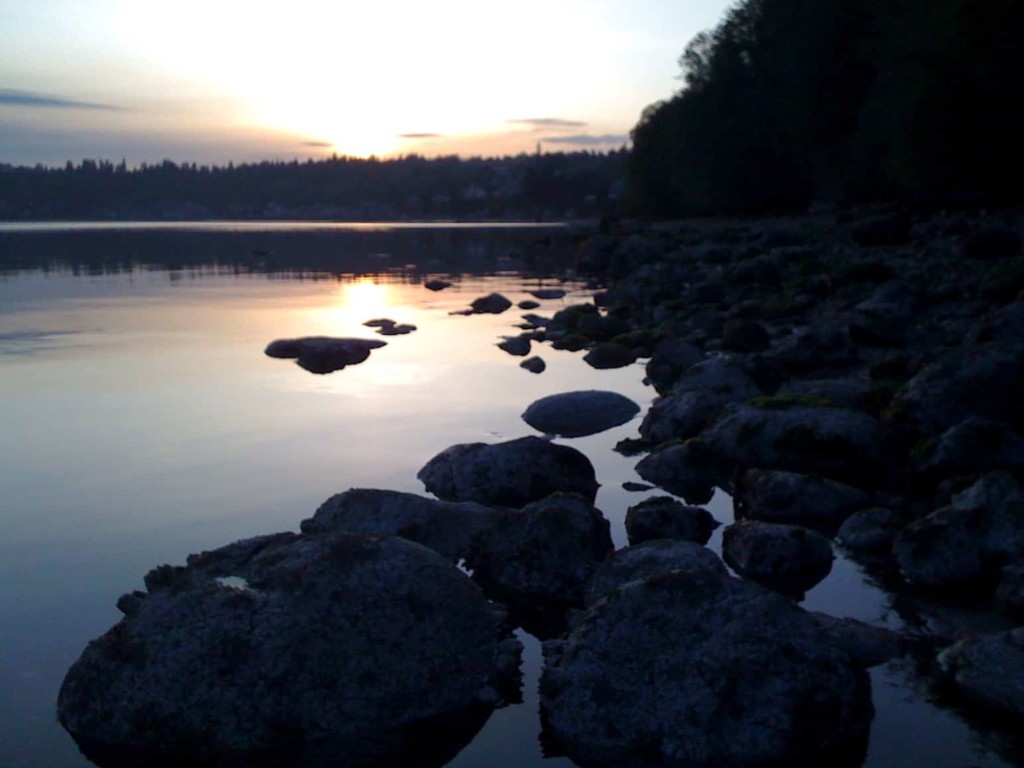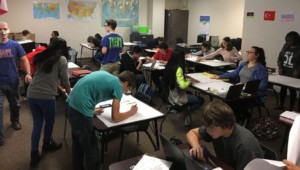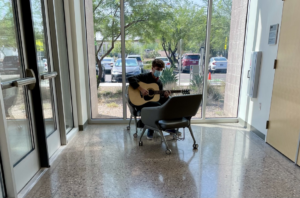Boundary High

A mile of limited access beach opens up on the south Puget Sound when the tide goes below six feet. With two 12 foot tidal swings daily, the rocky boundary between ocean and land is always changing on Poverty Bay.
Tidal bays launched my fascination with boundaries a decade ago. As Disrupting Class suggests, innovation occurs at the edges. What could be better preparation for life, than a school that studied the boundaries of civilization, technology, and knowledge?
Before outlining the world’s coolest school, I’ll outline a few conclusions about school design:
1. Traditional high schools are obsolete. Most of our students do not leave our large comprehensive high school with what they need and deserve. Nearly third of our students leave before they graduate including nearly half of the economically disadvantaged students of color. The old discipline based approach isn’t working; there is no focus, no integration, limited application, and it’s boring.
2. We know what has worked in the past. Small, personalized schools with a clear focus and coherent instructional program prepare nearly all students for college and careers. Good schools expect students to produce work that demonstrates research, communication, problem solving skills and an understanding of the civic and scientific concepts necessary to be a contributing citizen.
3. Blended learning will boost productivity. Based on higher ed, corporate training, online learning, and a few forward leaning schools, we can see that there are better ways to organize rapid pathways to mastery. Blending online and onsite learning holds the promise of higher learning and operating productivity.
Given these conclusions and the potential of studying boundaries of people, places, technologies, here’s the design of a pretty cool school:
Common intellectual mission: to ask and answer boundary questions through an interdisciplinary study of human development so that students will be well prepared for further learning and civic contribution.
In particular, students will learn to:
- Address complex problems individually and as a team member
- Effectively communicate a reasoned point of view
- Make leadership contributions to their communities
Themes: history unfolds at the boundaries that define how individuals relate to their community, how communities relate to new technology, how communities relate to the environment, and how communities relate to each other. These four boundary spaces will provide a framework for the curriculum as outlined below.
1.How people relate to communities: the role of the individual in society, to a great extent, defines that society, its culture, its customs, and its laws. Students will delve into two aspects of the individuals role:
- Rights and responsibilities: individual rights and civic responsibilities; the historical tug of war between justice and mercy and its expression in government and religion; the history of the Republic and the tension between the political right (liberty, responsibility, and merit) and the left (collectivism, protectionism, access, and opportunity).
- Right and wrong: how societies negotiate a shared sense of law, order, and morality; the role of religion in defining the law of the land and a shared sense of morality; how new scientific developments are testing old sensibilities, and how societies negotiating agreements.
2.How communities adopt technology: the study of human development is largely about how societies innovate and share new ways and presumably better ways of doing things.
- Innovation: the conditions that cause some societies to develop new technologies more rapidly than others.
- Diffusion: how innovations are spread throughout communities, the role public and private sectors in innovation diffusion.
3.How communities relate to the environment: in the broadest sense, communities take resources from the environment for sustenance and wealth accumulation, and they express themselves, often in relationship to their environment, through language, art and music.
- Extraction: how different communities extract benefit from the environment; the cost/benefit of progress, and sustainable development.
- Expression: how various communities express themselves through language, art and music and how that expression is shaped by their relationship to the environmen
4.How communities relate to other communities: the government, markets, and non-governmental agencies, and their relationships in international affairs:
- Nation versus nation: the evolution of nation states, their relationship one to another and the history of power and conflict; and the global economy.
- Public versus private: evolution of the public, private and third sector; how the three sectors address complex issues
Vision of good teaching and learning: students at Boundary High will ask and answer life’s most important questions individually and in teams. They will study important topics in depth and be asked to apply their learning to new challenges. Students will show what they know through frequent and varied demonstrations.
Approximately half of a student’s work will be independent with the guidance of an advisor and half will be as part of a learning team. Students will use technologies for inquiry, creation and demonstration. They physical space and organizational structure will support this vision of teaching and learning.
Structure: the school will be organized in two divisions of not more than 300 students: lower division and upper division, each of approximately 2 years in length. While in each division, students will complete a project in each of the four themes and participate in four seminars:
- Lower division students complete a project from each theme (rights and responsibilities, innovation, extraction, and nation versus nation) and participate in four seminar which introduce them to the framework of important knowledge disciplines
- Upper division students complete a project from each theme (right and wrong, expression, diffusion, and public versus private) and participate in four advanced seminars where they apply knowledge across disciplines and participate in work and community based learning.
Projects: Students will initiate each project with a project plan and abstract. They will conclude the project with the presentation of a research summary, persuasive essay and leadership application. The research summary will include an abstract an information map. The persuasive essay will clearly articulate a reasoned point of view. The leadership application will highlight a current event and leader or community service experience that illustrates the points made in the persuasive essay. The project work products will be presented to the student’s advisor, parent, and a community member and stored in a digital portfolio. Common scoring rubrics will allow the school to aggregate and report the results of project work to the school community (along with required tests).
Seminars: Students will complete four seminars in each division, two each year. They will frequently work together in teams of three or four. The four seminars are as follows:
1.Research and communication: the study of information science, English language arts, conversational Spanish, and presentation skills.
2.Problem solving: the study of algebra, probability and statistics, finance and economics.
3.Life on earth: an integrated study of physical and life sciences
4.Human development: an integrated study of the history including anthropology, archeology, philosophy, psychology and civics.
Instructional materials: Students in the lower division will read some human development classics like Guns, Germs and Steel by Jared Diamond and Culture Matters, Huntington & Harrison. Each seminar will use units of open education resources that present the organizing framework of each discipline, and will include the study of great literature.
Faculty, facilities and schedule: each division will be staffed by a team of 10 teachers that will each advise 20 students and teach one seminar. All teachers will be skilled in reading and writing instruction and project-based learning in a standards-based technology rich environment.
The school year will be 44 weeks long, or 220 days. Each year will begin with a one week of orientation, team building, study skills and project planning. Each school year will conclude with three weeks to finalize and present projects. Seminars will be conducted fours days per week for 20 weeks. Students will participate in two seminars concurrently. The 90 minute seminars will begin at 10:30am and 1pm. Students will sign up for the early shift (8-10:30am) or the late shift (2:30-5pm) when they will have access to their advisor and be required to show frequent evidence of progress on their projects. Students and advisors will also make frequent use of email and text communication. The 10 division teachers will meet daily for 30 minutes at improvement teams for 7:30 and the entire staff will meet for two hours every Friday. Teachers will also work in improvement teams for two hours on Friday.
Students will receive an Chromebook and are free to augment that with their own smart phone and laptop. Seminar teachers will work in pairs to create an information map for their seminars and create work that will engage and inspire students and by virtue of which they will 1) accumulate evidence of knowledge within disciplines, 2) apply knowledge within disciplines, 3) apply knowledge across disciplines, and (with their project work as well as seminar work) 4) apply knowledge to predictable problems, and 5) apply knowledge to unpredictable problems. (Adapted from William Daggett).
Approximately one third of the space will be devoted to individual student work spaces (each to be shared by an early shift and a late shift student), one third to seminar space, and one third to presentation and team work space. The Director of Boundary High will sit on a building council that will create sharing agreements for use of shared space and facilities. Students at Boundary will be able to participate in extracurricular activities with students from the other schools.
Boundary High will have a dedicated foundation and 100 business and community partners that will assist with leadership applications. Students, advisors, and parents will meet at least three each year to review progress and to plan for the future.
Students at Boundary High will ask and answer boundary questions.
For more see








0 Comments
Leave a Comment
Your email address will not be published. All fields are required.